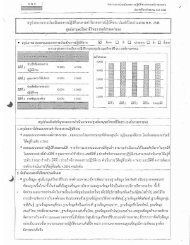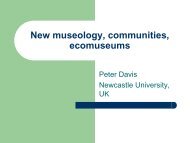Download
Download
Download
Create successful ePaper yourself
Turn your PDF publications into a flip-book with our unique Google optimized e-Paper software.
“Returning to the question at hand, can these local, intangible values inscribed in the sites existalongside these dominant narratives, or do these “authorized heritage discourses” (Smith 2006) firsthave to be deconstructed in order to create the space for alternative interpretations of heritage?”was to establish a local committee comprised ofcommunity leaders who would have a formally recognizedrole in decision-making about the management andinterpretation of the sites within the park. One headwomanfrom Ta Pek village, Ms. Pan Thitkratok, suggested thatsuch a local committee should have a role in planningthe annual Phnom Rung festival held each April togetherwith other key government offices and facilitating accessto the sanctuaries for locally organized cultural eventsand rituals. Another recommendation was to integratethe cultural maps into the local school curriculum as atool for teaching about the intangible values associatedwith the sanctuaries, thus fostering greater respect andunderstanding among younger generations.All in all, the field research and mapping processin the vicinity of the Phnom Rung Historical Park revealedthat the communities living near the archaeological siteshad inscribed these edifices with their own spiritualand mythical meanings, incorporating them into a livingcorpus of animist and Buddhist beliefs and practices.Indeed, this practice of reinterpreting and reincorporatingarchaeological sites into animist and Theravada Buddhistbelief systems has been widely observed by scholarsof Southeast Asia such as Srisaksa Vallibothama, whodescribed this widespread practice as a kind of revival andtransformation of “dead” religious architecture (Srisaksa1995).However, what this research also revealed isthe challenge of creating a space for recognition ofthese intangible meanings and living values in a nationalcontext where the field of heritage conservation is stillby-and-large focused on the preservation of the physicalfabric of the sites according to rationalist, scientific,and archaeological principles, and where access andmanagement of heritage sites is influenced by the touristindustry and by politicians. Returning to the question athand, can these local, intangible values inscribed in thesites exist alongside these dominant narratives, or dothese “authorized heritage discourses” (Smith 2006) firsthave to be deconstructed in order to create the space foralternative interpretations of heritage? The larger challengethat lies ahead is how to raise critical awareness amongthe different stakeholder groups in Thailand about theinherently multivalent and contested nature of heritage,and the rights of communities to have a say in how theirheritage is managed.References CitedAymonier, Etienne. [1901] 1999. Khmer Heritage in Thailand. Translatedby Walter E.J. Tips. Bangkok: White Lotus Press.Chandler, David. 2000. A History of Cambodia. Third edition. Boulder:Westview Press.Smith, Laurajane. 2006. The Uses of Heritage. New York: Routledge.Srisaksa Vallibhotama. 1995. “Sri Sa Ket: Sisaket khet khamen padong”[Srisaket: The Area of the ‘Backward Cambodians’]. In Khon ha aditkhong mueang boran, edited by Namphueng Ratana-ari, 373-401.Bangkok: Muang Boran.More detailed data and analysis about this researchproject can be found in a chapter in the forthcomingedited volume, Rights to Culture? Language, Heritageand Community in Thailand (Silkworm Press, 2013), andin an article in the centenary volume of the Journal of theSiam Society, entitled Protecting Siam’s Heritage (2013).A short film about the stakeholder forum and culturalmapping process in Buriram Province is available at theCulture and Rights in Thailand website: http://www.sac.or.th/databases/cultureandrights/







